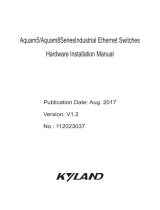
BAT-F, BAT-Rail, BAT54, BAT300
Release
02
07/10 17
The devices provide you with a large range of features:
XSturdy metal housing with protection class IP67 (BAT-F) or
protection class IP40 (BAT-Rail)
XSecure mounting on a flat surface (e.g. wall), a pole (BAT-F) or a DIN rail
(BAT-Rail)
XRedundant power supply with two 24 V supplies, Power over Ethernet,
and one 12 V supply
XTemperature range –30 °C to +50 °C
XWireless LAN interfaces in accordance with IEEE802.11b/g and
IEEE802.11a/h or IEEE802.11n (draft 2.0)
XCreation of redundant WLAN connections for secure data transmission
XMaximum security, also for point-to-point with encryption in accordance
with the IEEE802.11i standard
XRS-232 serial interface for configuration, remote access and the provision
of a serial gateway
XRadio modules can be operated separately as an access point or access
client (apart from BAT-Client types)
XFast and reliable roaming and prioritizing, also with 802.1x authentication
XHigh performance operating system with a wide range of functions via
MultiSSID, VLAN, Rapid SpanningTree, RADIUS server, IP router,
firewall, DHCP server, etc.
XManagement software for Windows, Web configuration, Telnet interface
and management via SNMP
Antenna technology for a high quality signal
XFor operation indoors and outdoors
XMounting with cables provided
XSecure wall and pole bracket
XOptimized distribution and performance for every application
XLong transmission distances
XDesigned for 2.4 GHz and 5 GHz wave bands
Cross-platform WLAN management
XA standardized, cross-platform management system for transparent
and efficient network monitoring (SNMP)
XWindows management suite: LANconfig, LANmonitor, WLANmonitor
XDirect management via Web browser (HTTP, HTTPS)
XCommand line level: TelNet
XCan always be reached via serial interface
XComplete and partial configuration of multiple devices via scripting
XWLANmonitor for convenient monitoring of WLANs with Rogue AP
Detection
XMonitoring of all BAT family devices as clients and as access points in
an application




















